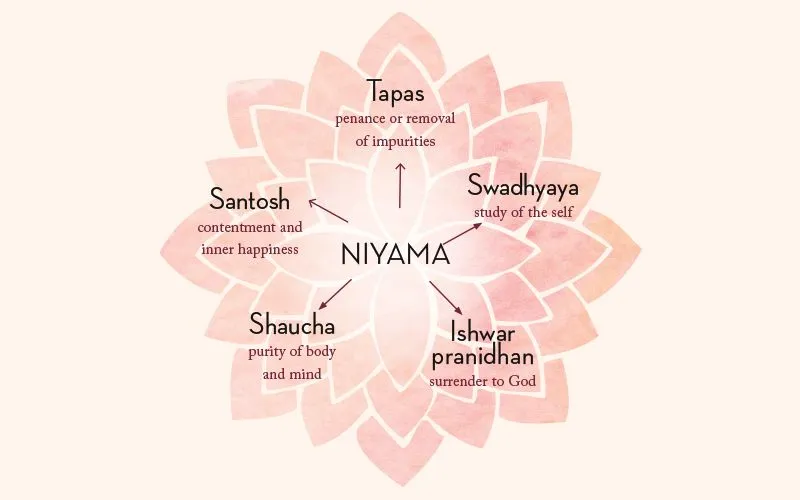Contents
What are the 5 Niyamas?
The word “Niyama” is derived from Sanskrit and is composed of two components: “ni” and “yama.” “Ni” means “rule” while “Yama“ means “control “.So, together, “Niyama” refers to the observance of rules or self-discipline.
Understanding 5 niyamas of yoga
-
Shaucha (Purity):

Shaucha is the first principle in Niyama Yoga, focusing on keeping our body and mind clean. It means making sure our surroundings are tidy and washing ourselves regularly to stay free from dirt and germs. Shaucha also means keeping our thoughts positive and avoiding negative ones. It’s not just about physical cleanliness but also being mindful of what we do, what we eat, and what’s around us. When we practice Niyama Yoga, we’re helping Shaucha by purifying our thoughts, body, and spirit
-
Santosha (Contentment):

-
Tapas (Austerity):

-
Svadhyaya (Self-study):

Svadhyaya is the four principle of Niyama Yoga. It is about looking deep inside ourselves and thinking carefully about who we are. By reading sacred texts, thinking deeply, and watching how we think and act, we can learn a lot about ourselves. This helps us become more aware of who we really are and grow as people. In Niyama Yoga, Svadhyaya reminds us to take time to understand ourselves better and also intertwined with the practice of Pranayama breath control techniques which can lead to personal growth and a better understanding of our place in the world.
Ishvara Pranidhana (Surrender to a Higher Power):

- Inner Peace: Following the ethical principles of Niyama Yoga promotes inner peace and tranquility by cultivating positive qualities such as contentment, purity, and surrender.
- Personal Growth: Engaging in self-discipline, self-study, and self-reflection encourages personal growth and self-awareness, leading to greater understanding of oneself and others.
- Stress Reduction: Niyama Yoga practices help manage stress levels by promoting mindfulness, resilience, and emotional balance.
- Enhanced Well-being: By focusing on cleanliness, healthy habits, and positive mindset, Niyama Yoga contributes to overall physical health and vitality.
- Spiritual Development: Surrendering to a higher power and cultivating a deeper connection with the divine fosters spiritual growth and a sense of purpose and fulfillment in life.
- Improved Relationships: Practicing contentment, self-discipline, and self-awareness in Niyama Yoga can lead to healthier and more harmonious relationships with oneself and others.
- Clarity of Mind: Through self-study and introspection, Niyama Yoga helps clear mental clutter and cultivate clarity, focus, and inner strength.
Difference Between Yamas and Niyamas
| Yamas | Niyamas |
|---|---|
| 1. Ethical guidelines for interactions with others and the external world | 1. Ethical guidelines for personal behavior and inner growth |
| 2. Focus on social conduct and relationships | 2. Focus on self-discipline and spiritual development |
| 3. External observances | 3. Internal observances |
| 4. Includes principles like non-violence (Ahimsa), truthfulness (Satya), non-stealing (Asteya), sexual continence (Brahmacharya), and non-possessiveness (Aparigraha) | 4. Includes principles like purity (Shaucha), contentment (Santosha), self-discipline (Tapas), self-study (Svadhyaya), and surrender to a higher power (Ishvara Pranidhana) |
| 5. Focuses on how we interact with the world around us | 5. Focuses on how we cultivate inner qualities and personal growth |
| 6. Guidelines for moral conduct and integrity | 6. Guidelines for cultivating virtues and spiritual practices |
| 7. Foundation for harmonious social living | 7. Foundation for holistic well-being and self-realization |
Practice Tips for Niyama Yoga

- Set Intentions: Begin each day by setting intentions aligned with the principles of Niyama, such as practicing contentment, self-discipline, or self-study.
- Morning Rituals: Establish a morning routine that includes practices like meditation, journaling, or yoga asanas to cultivate inner peace and self-awareness.
- Daily Reflection: Take time each day for self-reflection and introspection. Reflect on your thoughts, emotions, and actions, and consider how they align with the principles of Niyama.
- Gratitude Practice: Cultivate an attitude of gratitude by acknowledging and appreciating the blessings in your life. Practicing gratitude fosters contentment and joy.
- Mindful Living: Practice mindfulness in your daily activities, whether it’s eating, walking, or interacting with others. Pay attention to the present moment and approach each task with awareness and presence.
- Self-care: Prioritize self-care activities that promote physical, mental, and emotional well-being. This can include nourishing your body with healthy food, getting enough rest, and engaging in activities that bring you joy.
- Study and Learning: Dedicate time to self-study and personal growth. Read books, listen to podcasts, or attend workshops that inspire and challenge you to deepen your understanding of yourself and the world around you.
- Connect with Nature: Spend time outdoors connecting with nature. Nature has a grounding and rejuvenating effect that can help foster a sense of connection and inner peace.
- Service to Others: Practice seva or selfless service by offering help and support to others in need. Acts of kindness and compassion contribute to a sense of interconnectedness and fulfillment.
- Regular Practice: Make Niyama Yoga a consistent part of your life by incorporating these principles into your daily routines and habits. Consistent practice is key to experiencing the transformative power of Niyama Yoga.
Conclusion
